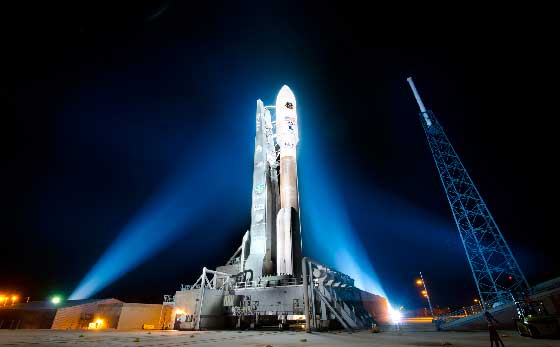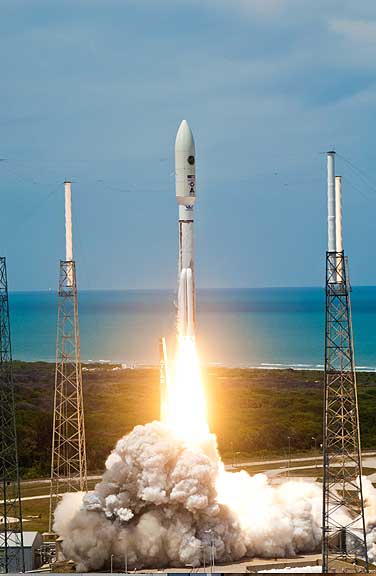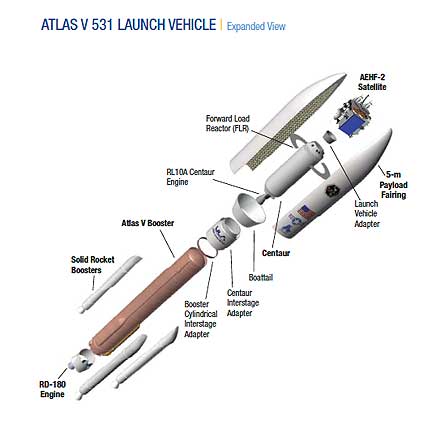
Before the launch...A United Launch Alliance Atlas V launch vehicle stands ready to launch the Air Force's AEHF-2 satellite at Space Launch Complex-41 at Cape Canaveral Air Force Station.

After...Cape Canaveral Air Force Station, Fla. (May 4, 2012) – A United Launch Alliance Atlas V rocket blasts off from Space Launch Complex-41 at 2:42 p.m. EDT with the U.S. Air Force’s Advanced Extremely High Frequency-2 (AEHF-2) satellite. This was ULA’s 4th launch of an aggressive 11 mission schedule for the year and marks the 30th Atlas V mission and the 60th launch for ULA in just over five years. The AEHF constellation is a joint-service satellite communications system that will provide survivable, global, secure, protected and jam-resistant communications for high-priority military ground, sea and air assets. Photo by Pat Corkery, United Launch Alliance
Rob Gannon gave the play-by-play for ULA's successful launch today, Friday, May 4, at Complex-41 at Cape Canaveral Air Force Station in Florida of the Air Force's AEHF-2 satellite. All systems ran perfectly, and once launched all the exercises ran, and continue to run, as planned.
May 4 Launch Statement from the U.S. Air Force...
LOS ANGELES AIR FORCE BASE, El Segundo, Calif. — The U.S. Air Force successfully launched the second Advanced Extremely High Frequency spacecraft at 2:42 p.m. EDT, May 4 from Space Launch Complex 41 at Cape Canaveral Air Force Station, Fla. The satellite was carried aboard an Atlas V launch vehicle.
With successful satellite separation from the launch vehicle approximately 51 minutes after liftoff, AEHF-2 will undergo approximately 110 days of orbit-raising operations followed by approximately 120 days of on-orbit testing. After these critical events, AEHF-2 will be ready to transfer to the 14th Air Force for Satellite Control Authority.
“We are proud of our entire launch team.” said Col. Michael Sarchet, AEHF Government Program Manager. “Each AEHF spacecraft will provide warfighters’ much improved protected communications capabilities.”
AEHF is a joint service satellite communications system that will provide survivable, global, secure, protected, and jam-resistant communications for high-priority military ground, sea and air assets. The AEHF system is the follow-on to the Milstar system, augmenting, improving and expanding the Department of Defense’s MILSATCOM architecture.
AEHF-2 was procured from Lockheed Martin Space Systems Company by the MILSATCOM Systems Directorate, part of the Air Force Space Command’s Space and Missile Systems Center. The MILSATCOM Systems Directorate plans, acquires and sustains space-based global communications in support of the president, secretary of defense and combat forces. The MILSATCOM enterprise consists of satellites, terminals and control stations and provides communications for more than 16,000 air, land and sea platforms.
...and May 4, Launch Statement From ULA...
Cape Canaveral Air Force Station, Fla., (May 4, 2012) – A United Launch Alliance (ULA) Atlas V rocket carrying the Advanced Extremely High Frequency-2 (AEHF-2) satellite for the United States Air Force lifted off from Space Launch Complex-41 here at 2:42 p.m. EDT today. This was ULA’s 4th launch of an aggressive 11 mission schedule for the year and marks the 30th Atlas V mission and the 60th launch for ULA.
"ULA is proud to serve alongside our mission partners and privileged that the Air Force entrusts the ULA team to deliver critical national security capability to orbit for our soldiers, sailors, airman and Marines around the world,” said Jim Sponnick, ULA vice president, Mission Operations. “Through our focus on attaining Perfect Product Delivery, ULA remains dedicated to providing reliable, cost-effective launch services while continuing our unwavering commitment to 100 percent mission success. Today’s successful launch was the 60th since ULA was formed just over five years ago and we congratulate the AEHF team on this important step toward delivering these critical protected communications capabilities.”
This mission was launched aboard an Atlas V Evolved Expendable Launch Vehicle (EELV) 531 configuration vehicle, which includes a 5-meter diameter RUAG Space payload fairing along with three Aerojet solid rocket motors attached to the Atlas booster. The Atlas booster for this mission was powered by the RD AMROSS RD-180 engine and the Centaur upper stage was powered by a single Pratt & Whitney Rocketdyne RL10A engine.
The AEHF constellation is a joint-service satellite communications system that will provide survivable, global, secure, protected and jam-resistant communications for high-priority military ground, sea and air assets.
Developed by the United States Air Force to provide assured access to space for Department of Defense and other government payloads, the EELV Program supports the full range of government mission requirements, while delivering on schedule and providing significant cost savings over the heritage launch systems.
ULA's next launch is the Atlas V NROL-38 mission for the National Reconnaissance Office scheduled June 18 from Space Launch Complex-41 at Cape Canaveral Air Force Station, Fla.
ULA program management, engineering, test, and mission support functions are headquartered in Denver, Colo. Manufacturing, assembly and integration operations are located at Decatur, Ala., and Harlingen, Texas. Launch operations are located at Cape Canaveral AFS, Fla., and Vandenberg AFB, Calif.
AEHF satellites are the follow-on to the Department of Defense’s current five-satellite Milstar communications constellation. When fully operational, the Advanced EHF constellation will consist of four crosslinked satellites providing 10 times the throughput of the Milstar system with a substantial increase in coverage to users.
The Air Force’s Military Satellite Communications Systems Directorate (SMC/ MC) is the lead agency responsible for managing the AEHF contract. SMC/MC ensures that the secure communications capabilities of this system are made available to military personnel around the globe.
AEHF-2 SATELLITE | Overview
The AEHF system is a joint service satellite communications system that provides survivable, global, secure, protected, and jam-resistant communications for high-priority military ground, sea and air assets. Advanced EHF allows the National Security Council and Unified Combatant Commanders to control tactical and strategic forces at all levels of conflict through general nuclear war and supports the attainment of information superiority.
The AEHF system augments and improves on the capabilities of Milstar and expands the SMC/MC architecture. It provides connectivity across the spectrum of mission areas, including land, air and naval warfare; special operations; strategic nuclear operations; strategic defense; theater missile defense; and space operations and intelligence.
The AEHF system is composed of three segments: space (the satellites), ground (mission control and associated communications links), and terminals (the users). The segments provide communications in a specified set of data rates from 75 bps to approximately 8 Mbps. The space segment consists of a cross-linked constellation of four satellites in geosynchronous earth orbit. The mission control segment controls satellites on orbit, monitors satellite health, and provides communications system planning and monitoring. This segment is highly survivable, with both fixed and mobile control stations. System uplinks and crosslinks operate in the extremely high frequency (EHF) range and downlinks in the super high frequency (SHF) range. The terminal segment includes fixed and ground mobile terminals, ship and submarine terminals and airborne terminals used by all of the services and international partners (Canada, Netherlands, and UK).
Weighing in at approximately 13,600-lb, fully fueled, the satellite is based on the Lockheed Martin A2100 commercial satellite that includes hall current thruster electric propulsion, which is 10 times more efficient than conventional bipropellant systems. The thrusters remove orbit eccentricity during transfer orbit operations, orbit maintenance and satellite repositioning. The payload features onboard signal processing and crossbanded EHF/SHF communications. Increased coverage is provided by antennas consisting of two SHF downlink phased arrays, two crosslinks, two uplink/downlink theater anti-jam nulling antennas, one uplink EHF phased array, six uplink/downlink gimbaled dish antenna, one each uplink/downlink earth coverage horns.

ATLAS V 531 LAUNCH VEHICLE | Overview ATLAS V 531 LAUNCH VEHICLE | Expanded View The Atlas V 531 consists of a single Atlas V booster stage, the Centaur upper stage, three solid rocket boosters (SRBs), and a 5-m payload fairing (PLF).
The Atlas V booster is 12.5 ft in diameter and 106.5 ft in length. The booster’s tanks are structurally rigid and constructed of isogrid aluminum barrels, spun-formed aluminum domes, and intertank skirts. Atlas booster propulsion is provided by the RD-180 engine system (a single engine with two thrust chambers). The RD-180 burns RP-1 (Rocket Propellant-1 or highly purified kerosene) and liquid oxygen, and it delivers 860,200 lb of thrust at sea level. The Atlas V booster is controlled by the Centaur avionics system, which provides guidance, flight control, and vehicle sequencing functions during the booster and Centaur phases of flight.
The SRBs are approximately 61 in. in diameter, 67 ft in length, and constructed of a graphite epoxy composite with the throttle profile designed into the propellant grain. The SRBs are jettisoned by structural thrusters following a 92-second burn.
The Centaur upper stage is 10 ft in diameter and 41.5 ft in length. Its propellant tanks are constructed of pressure-stabilized, corrosion resistant stainless steel. Centaur is a liquid hydrogen/liquid oxygen- (cryogenic-) fueled vehicle. It uses a single RL10A-4-2 engine producing 22,300 lb of thrust. The cryogenic tanks are insulated with a combination of helium-purged insulation blankets, radiation shields, and closed-cell polyvinyl chloride (PVC) insulation. The Centaur forward adapter (CFA) provides the structural mountings for vehicle electronics and the structural and electronic interfaces with the spacecraft.
The AEHF-2 satellite is encapsulated in the Atlas V 5-m diameter short PLF. The 5-m PLF is a sandwich composite structure made with a vented aluminum-honeycomb core and graphite epoxy face sheets. The bisector (two-piece shell) PLF encapsulates both the Centaur and the spacecraft, which separates using a debris-free pyrotechnic actuating system. Payload clearance and vehicle structural stability are enhanced by the all-aluminum forward load reactor (FLR), which centers the PLF around the Centaur upper stage and shares payload shear loading. The vehicle’s height with the 5-m short PLF is approximately 197 ft.

